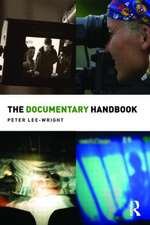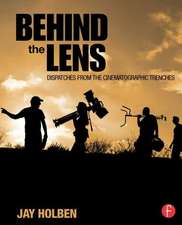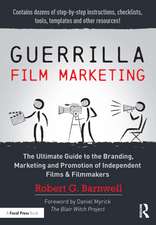Preparing For Takeoff: Preproduction for the Independent Filmmaker
Autor Arthur Vincieen Limba Engleză Hardback – 2 aug 2017
| Toate formatele și edițiile | Preț | Express |
|---|---|---|
| Paperback (1) | 239.30 lei 6-8 săpt. | |
| Taylor & Francis – 11 feb 2013 | 239.30 lei 6-8 săpt. | |
| Hardback (1) | 1014.74 lei 6-8 săpt. | |
| Taylor & Francis – 2 aug 2017 | 1014.74 lei 6-8 săpt. |
Preț: 1014.74 lei
Preț vechi: 1366.53 lei
-26% Nou
Puncte Express: 1522
Preț estimativ în valută:
194.19€ • 201.59$ • 161.93£
194.19€ • 201.59$ • 161.93£
Carte tipărită la comandă
Livrare economică 24 martie-07 aprilie
Preluare comenzi: 021 569.72.76
Specificații
ISBN-13: 9781138426115
ISBN-10: 1138426113
Pagini: 352
Dimensiuni: 184 x 260 x 28 mm
Greutate: 0.45 kg
Ediția:1
Editura: Taylor & Francis
Colecția Routledge
Locul publicării:Oxford, United Kingdom
ISBN-10: 1138426113
Pagini: 352
Dimensiuni: 184 x 260 x 28 mm
Greutate: 0.45 kg
Ediția:1
Editura: Taylor & Francis
Colecția Routledge
Locul publicării:Oxford, United Kingdom
Public țintă
Professional Practice & DevelopmentRecenzii
"I recommend Preparing for Takeoff to anyone making an independent film. While there are other books on the subject, what sets this one apart is how well it explains the balance between the artistic process the writer/director goes through and the practical decisions the producer has to consider, especially when working low budget. Vincie shows how the two affect each other and offers creative solutions for dealing with limited resources without compromising the filmmaker's artistic vision."
- Dorothy Rompalske, Film Department, Brooklyn College, CUNY
- Howard Libov, Writer/Director, Favorite Son and Midnight Edition, Professor, Film Department, Fairleigh Dickinson University
- Sal Petrosino, Director of Operations, Film, Video and Animation Department, School of Visual Arts
Notă biografică
Arthur Vincie has over fifteen years of film and television production experience as a line producer, producer, and director. Vincie has line produced or production managed numerous independent films and is very active in the New York City independent filmmaking community. He has done production work for major television networks, including NBC, ABC, and BBC America. He founded and currently runs Chaotic Sequence Inc., a company that produces shorts and features. He recently wrote and directed the feature film Found in Time , which won the Best Sci-Fi Feature at the 2012 Shriekfest Sci-Fi/Horror film festival.
Cuprins
Part I: Early Days and the Big Picture Chapter 1: The Film Life Cycle Chapter 2: Preparing Your Business Chapter 3: Fixing the Script Chapter 4: Working with Other People Chapter 5: Assembling Your Initial Team Chapter 6: Marketing Part II: The Director's Path Chapter 7: Script Analysis Chapter 8: Gathering Materials Chapter 9: Prep for Casting Part III: The Producer's Path Chapter 10: The Breakdown Chapter 11: The Budget Chapter 12: Thinking Strategically Chapter 13: Vendors, Equipment, Negotiations Chapter 14: Dealing with Guilds and Unions Part IV: Joint Preparation Chapter 15: Casting Chapter 16: Location Scouting Chapter 17: Hiring Your Crew Chapter 18: Rehearsals Chapter 19: Tech Scouting Chapter 20: Previsulization Part V: The Shoot and After Chapter 21: Routines for Success in Production Chapter 22: Preparing for Post Chapter 23: Preparing for Distribution Chapter 24: Beyond Basic Planning Appendices Appendix A: Further Reading/Tools/Resources Appendix B: Helpful Forms
Descriere
In a unique and integrated approach, The Definitive Guide to Emergency Department Operational Improvement: Employing Lean Principles with Current ED Best Practices to Create the "No Wait" Department exposes you to the academics behind managing the complex service environment that is the ED. The book combines applied management science and ED experience to create a model of how to improve your emergency department operations. After summarizing the current state of emergency medicine, the book offers an in-depth presentation of Lean tools used in the ED along with basic and advanced flow principles grounded in queuing theory and the theory of constraints. It then shows how these concepts are applied in the emergency department and why they work, supported by a comprehensive case study in which Lean principles were used to transform an underperforming ED into a world-class operation. The authors highlight three commonly referenced intervals in the ED: door to doc (input), doc to disposition (throughput), and disposition to departure (output). After reviewing best practices, the authors explain how to achieve excellence in your own environment by discussing change management, leadership, dealing with resistance, and other critical elements of creating a culture of change. Under any scenario realized by healthcare reform, this book provides the tools and concepts to improve your ED for patients, staff, the organization, and ultimately, society.






















